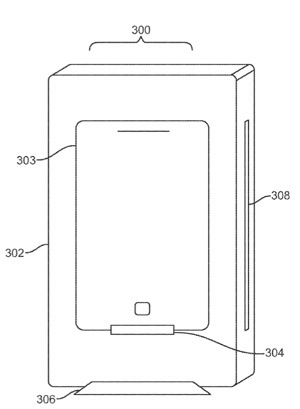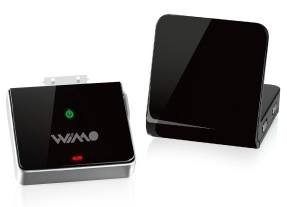An Apple patent (number 7971782) for a multi-point [of sale] transaction system has appeared at the US Patent & Trademark Office. It relates to temporarily pairing devices to complete transactions; and more specifically to temporarily pairing at least one handheld communication device selected from a plurality of handheld communication devices with at least one payment terminal selected from a plurality of payment terminals.
Computer implemented systems and methods for conducting transactions are disclosed in the patent. In one exemplary embodiment, a method includes receiving transaction information corresponding to a transaction initiated with one of a plurality of handheld computing devices. The handheld computing device is associated with one of a plurality of payment terminals. The transaction is completed and the association between the handheld computing device and the payment terminal is terminated. Khawaja Shams is the inventor.
Here’s Apple’s background and summary of the invention: “In the sale of goods from merchants to consumers, point-of-sale systems are used to complete transactions. The shopping experience of a consumer can be heavily influenced by the method in which a transaction is consummated at the point-of-sale. One drawback of conventional point-of-sale systems is that they are in a fixed location. Such systems require a potential purchaser to select an item for purchase and then find a point-of-sale. Along the way purchasing decisions can change and a sale can be lost. Additionally, long lines can also cause a potential customer to walk away from a purchase.
Among other reasons why point-of-sale systems are traditionally stationary is that some financial transactions can only be carried out using specialized payment terminal devices, such as a HYPERCOM payment terminal, produced by Hypercom Corporation, Phoenix, Ariz. For example, these payment terminals are the only devices certified to carry out financial transactions requiring a user to enter a personal identification number (PIN). These payment terminals for implementing such payment methods are specifically designed to comply with strict banking and security protocols. Each country or state may require variations in security and architectural design for certifying authorized payment terminals. Therefore, payment terminals are often independent designed devices that are not designed for integration with other non-certified devices.
“The disclosed technology overcomes the drawbacks of the prior art technologies by providing a roaming point-of-sale system that can be paired with a certified payment terminal to complete transactions requiring such payment terminals.
“The following disclosure relates to multi-point transaction systems and methods, wherein any roaming point-of-sale system can be paired with any available payment terminal to complete a transaction. Using a roaming point-of-sale system, a sales associate can initiate a sales transaction with a customer at any location within a store. In many cases, such as if the customer pays with a credit card, the sales associate can complete the transaction at the point of contact with the customer.
“However, if the customer would like to pay with a bankcard, or other payment form that requires entry of a PIN to complete the transaction, the sales associate can bring the customer to a payment terminal to complete the transaction. A plurality of payment terminals are preferably located throughout the store to minimize drawbacks associated with stationary point-of-sale systems.
“The present technology initiates a transaction with one of a plurality of roaming point-of-sale systems carried by sales associates within the retail store. Preferably, each sales associate will have their own roaming point-of-sale system. When a payment terminal is required to complete the transaction, a sales associate can pair her roaming point-of-sale system with one a plurality of payment terminals located throughout the retail store for the purpose of completing the sales transaction.
“Pairing a roaming point-of-sale system with a payment terminal can require the roaming point-of-sale system to be identified to the payment terminal or vice versa. This can be completed by moderating the transaction with an in-store server. A roaming point-of-sale system can request to be paired with an identified payment terminal. The payment terminal can be identified by a unique name, an Internet protocol address (IP address) of the device on the network, or identifying information embedded into a barcode, as examples.
“The roaming point-of-sale system can request a server to broker a pairing between the roaming point-of-sale system and the identified payment terminal. The server can then associate the roaming point-of-sale system with the payment terminal and confirm that the payment terminal is properly identified by sending a pairing code to both devices. The pairing code can be read by the sales associate and entered into the payment terminal, which is now expecting the pairing code at the instruction of the server.
“Entering the proper pairing code can complete the pairing process and the roaming point-of-sale system can communicate with the payment terminal via the in-store network to communicate product or transaction information such as an amount to be charged to complete the sale.
“The payment terminal can receive a PIN from the customer, which authorizes the transaction. The payment terminal can complete the financial transaction by communicating with a clearinghouse to approve and secure payment for the specified amount.
“The payment terminal can report payment confirmation to the roaming point-of-sale system. A record of the entire transaction can be recorded by the in-store server for accounting, and inventory purposes, etc.
“Upon completion of the transaction, the paired relationship between the roaming point-of-sale system and the payment terminal is terminated to allow for pairing of either the roaming point-of-sale system or the payment terminal with other devices to complete other transactions.
“Accordingly, the present technology provides for methods and systems for temporarily pairing a device selected from a pool of such devices, with another device, selected form a pool of such devices. One potential use for such technology is in the retail store environment.”
— Dennis Sellers



![[NPL] Spring Cleaning 3.0](https://www.mactech.com/wp-content/themes/Extra/images/post-format-thumb-text.svg)
